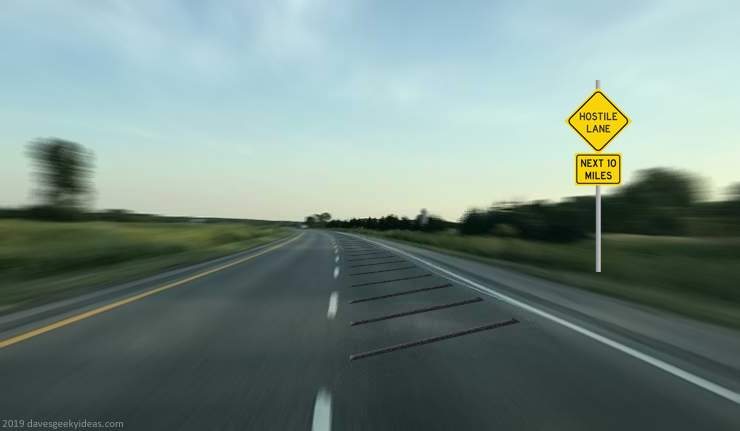
Imagine a lane of highway that is laced with bumps for several miles. It hates you and your car, and doesn’t want you driving on it at all. If it could talk, it would yell at you to move to the next lane over. WHY on earth would I share this idea? Because it might improve traffic flow on congested highways, at least that’s my theory.
Contrary to the picture above, I imagined Hostile Lanes as a fixture for major highways in dense urban areas. I was inspired by several treks through Seattle on the I-5. I will do my best to explain:
Hostile Lanes are designed to keep a lane (the right-most lane) clear of traffic, so it would only be used by drivers who are entering or exiting a highway.
I believe that by keeping this lane clear, traffic flow would be constant, even during rush hour. The potential for log jams from lots of drivers exiting or entering the highway are minimized because there aren’t a bunch of people needlessly clogging the right lane.
Hostile Lanes, thanks to their annoying bumps, encourage people to use the lane as little as possible, and only when absolutely necessary.
Ideal for stretches of highways with lots of congestion and numerous exits. Could potentially be used on residential roads trying to reduce traffic.
Again, just a theory. I’m not a civil engineer and I rely too much on Siri for basic math equations, if that gives you any idea how smart I am.


I think this is one of the best ideas I’ve heard in a long time!
This would only do as you described in light to moderate traffic where the other 2 lanes can handle the flow. It would do the opposite in the case of heavy traffic. In heavy traffic where the problem is throughput, this would now cause the “hostile lane” to slow down a large portion of the traffic that must be in that lane due to the number of cars. This is just my non-civil engineer opinion as well.
One problem I see in LA and SF today is the “Car-pool” lane entry/exit points. They typically put these points .5 miles or so before and after on/off ramps. What happens is that this causes cars in the car-pool lane to have to cross all lanes of traffic in .5 miles AND cars entering the freeway to cross all lanes to get to the car-pool lane in .5 miles. This causes an “X” of cars crossing all lanes of the freeway with the other cars in the middle lanes. It is totally counter-productive.
Interesting idea, but I think you’ll find that traffic authorities tend to prefer traffic to favour the outside lanes rather than the inside lanes. In Australia, there is a road rule that specifies that on roads where the speed limit is above 80km/h, drivers must not remain in the inside lane (closest to the centre median) unless overtaking. Therefore, your idea of hostile lanes may actually be put to better use by putting them in the inside lane at regular intervals in the hope that it annoys right lane hogs (remembering that here in Australia we drive on the opposite side of the road to you) enough to encourage them to vacate the lane. The downside is that the bumps will affect cars with softer suspension (like offroaders) less than those with firmer suspension (sports cars).
In terms of managing traffic flows, alternative methods are already in use in many jurisdictions. Vicroads (the roads authority here in Victoria, Australia) uses something called Coordinated ramp signals, which control the flow of traffic onto freeways with the aim of optimizing the flow of traffic along the entire length of the freeway,
https://www.vicroads.vic.gov.au/traffic-and-road-use/traffic-management/managed-motorways/coordinated-ramp-signals
Really enjoying your ideas - I respect how you have actually put thought into the practicality and realism of the ideas, whether there is actually a practical way they can be implemented or manufactured. I particularly like the two Mjolnir toolkits and your front door anti-theft mailbox. Thank you!